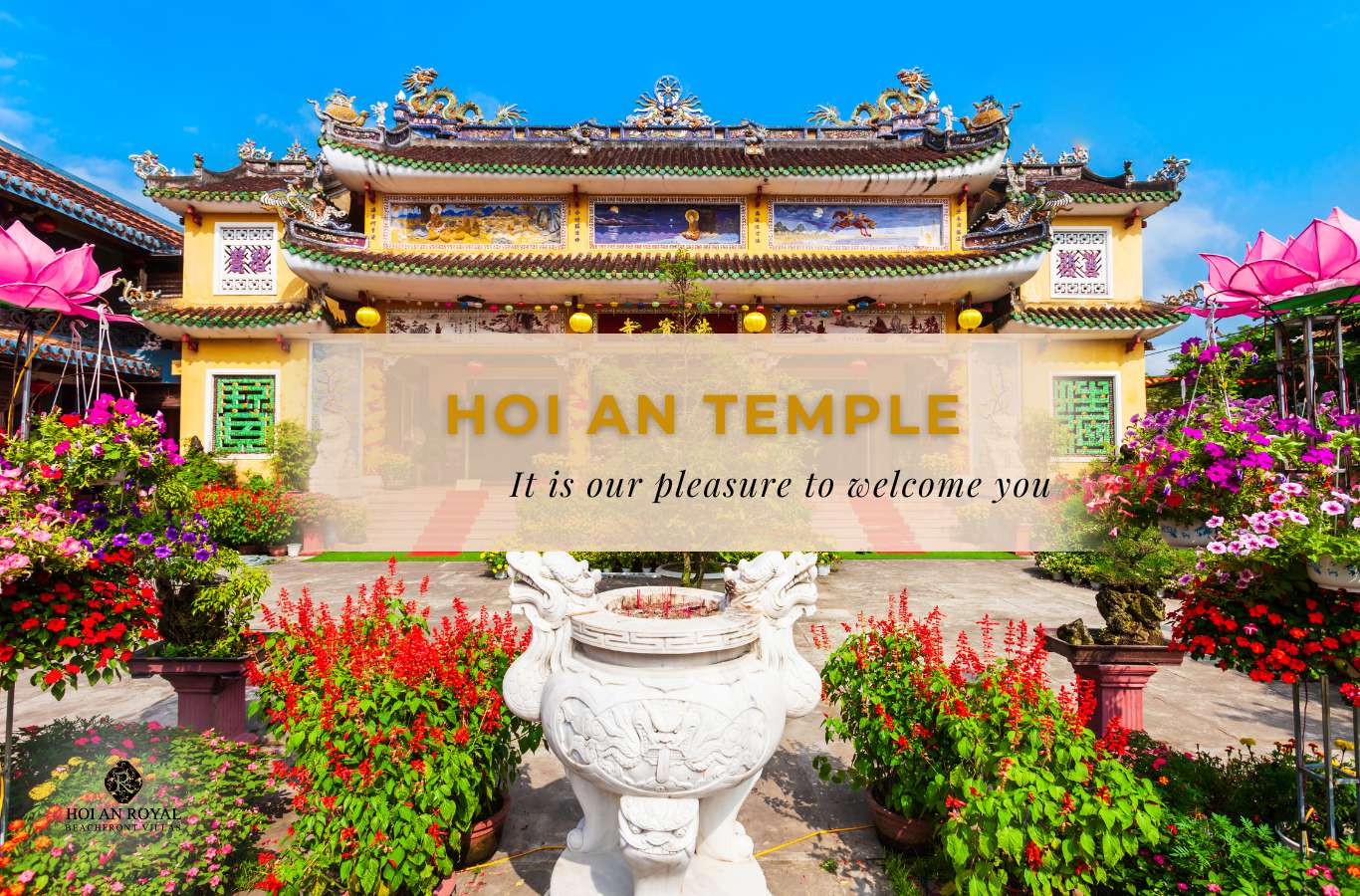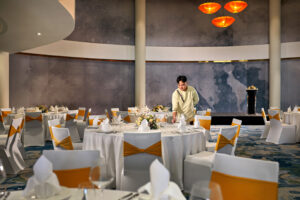Hoi An temple not only carries an ancient beauty but also embodies the cultural and spiritual depth of the old town. If you want to gain deeper insight into the architecture and the stories behind the most famous temples, don’t miss the article from Hoi An Royal Beachfront Villas for a more comprehensive perspective and fulfilling experience.
Table of Contents
ToggleList of the 10 most famous Hoi An temples you should visit
Ong Temple (Quan Cong Mieu)
Ong Temple, also known as Quan Cong Mieu, was built around 1653 by the Minh Huong community and Vietnamese people in Hoi An. It is dedicated to Guan Yu – a talented general of the Three Kingdoms period, symbolizing loyalty and honor. The temple was once a major religious center, attracting merchants who came to pray for good fortune and finalize transactions.
The architecture of Ong Temple features distinct Chinese influences with the “Quoc” character layout including four sections: front hall, left hall, right hall, and main sanctuary. The glazed tile roof, combined with lemon blossom dragon motifs and white porcelain fragments on the rafters, creates a refined beauty.
Inside the temple stands a statue of Guan Yu with a sharp, dignified gaze, flanked by statues of his horse, Chi Tho, and his loyal attendants. The temple also preserves many horizontal boards, parallel sentences, and ancient items such as a bronze bell and wooden drum from the Bao Dai era, adding cultural and historical value.
Despite several restorations, Ong Temple retains its distinctive architecture. In 1991, it was recognized as a National Historical and Cultural Monument, reflecting its significant role in the spiritual life of Hoi An residents.
The temple is located at 24 Tran Phu Street, right in the center of the ancient town, opposite the main market and near many attractions, making it convenient for visitors to explore.
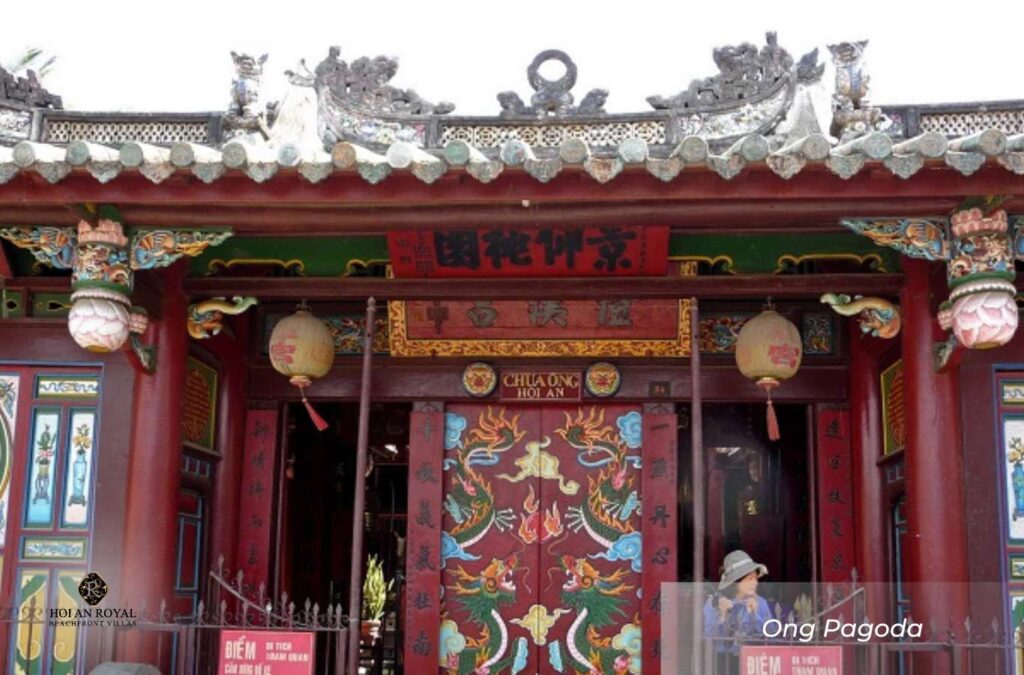
Japanese Covered Bridge (Lai Vien Kieu)
The Japanese Covered Bridge is an iconic symbol of Hoi An ancient town, noted for its architectural blend of Japanese, Chinese, and Vietnamese styles. This roofed wooden bridge was built in the late 16th – early 17th century by Japanese merchants to connect the Japanese and Chinese quarters.
The bridge is about 18 meters long and 3 meters wide, made of wood with yin-yang roof tiles in the “Thuong gia ha kieu” style (a house on top and a bridge below). The roof curves gracefully, supported by solid stone arches. At the entrance hangs a horizontal board with the inscription “Lai Vien Kieu,” a gift from Lord Nguyen.
At both ends of the bridge are wooden statues of a monkey and a dog – sacred animals held in reverence by the Japanese. Inside the temple is a shrine to the Northern God Tran Vo – a deity protecting the land, symbolizing the residents’ wish for peace. The bridge has seven wooden compartments, with narrow corridors once used for resting and trading.
The Japanese Covered Bridge is the only remaining ancient bridge in the old town, recognized as a National Historical and Cultural Monument since 1990. More than a transportation structure, it represents the East Asian cultural spirit of Hoi An. Its image appears on the 20,000 VND polymer banknote, signifying its national symbolic status. Currently, the bridge faces subsidence risks due to wastewater erosion and requires strict preservation efforts.
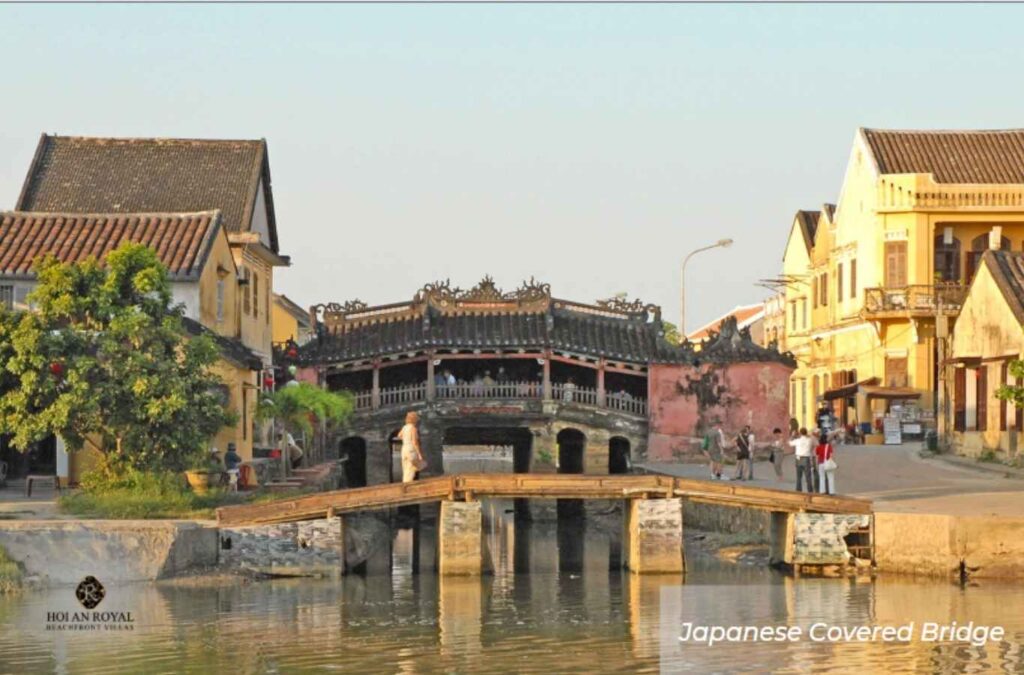
Ba Mu Temple
Ba Mu Temple is an important architectural and spiritual site in Hoi An ancient town, associated with the Minh Huong and Chinese communities. Built in 1626, the temple was originally part of the Cam Hai Nhi Cung complex, with two separate worship areas: Cam Ha Cung and Hai Binh Cung. The temple is commonly known for its dedication to the 12 Midwives and local deities.
The temple suffered severe damage during wartime, and by 1965 only the triple-entrance gate remained. In 2016, Hoi An invested nearly 12 billion VND to restore the gate and renovate the surroundings with a lotus pond, trees, and walkways, creating a peaceful space that attracts visitors.
The architecture includes a vibrant triple-entrance gate, a three-compartment hall for worship, a stele house, two auxiliary houses, and a spacious courtyard. The main hall worships Thien Hau Holy Mother, the 12 Midwives, and two guardian deities; the left hall honors Bao Sanh Dai and 36 other deities; the right hall worships Tho Ky and the ancestral temple of the Minh Huong community, reflecting the diverse beliefs of the Chinese community.
With intricate carvings, curved roof tiles, and mossy yellow walls, the temple exudes a sacred, ancient ambiance. It is a key monument contributing to Hoi An ancient town’s recognition as a UNESCO World Cultural Heritage Site, preserving traditional spiritual values.
Today, the temple serves as both a spiritual site and a popular “check-in” location with its vibrant gate and harmonious landscape. Its preservation is seen as vital to maintaining cultural heritage and promoting local tourism and spiritual identity.
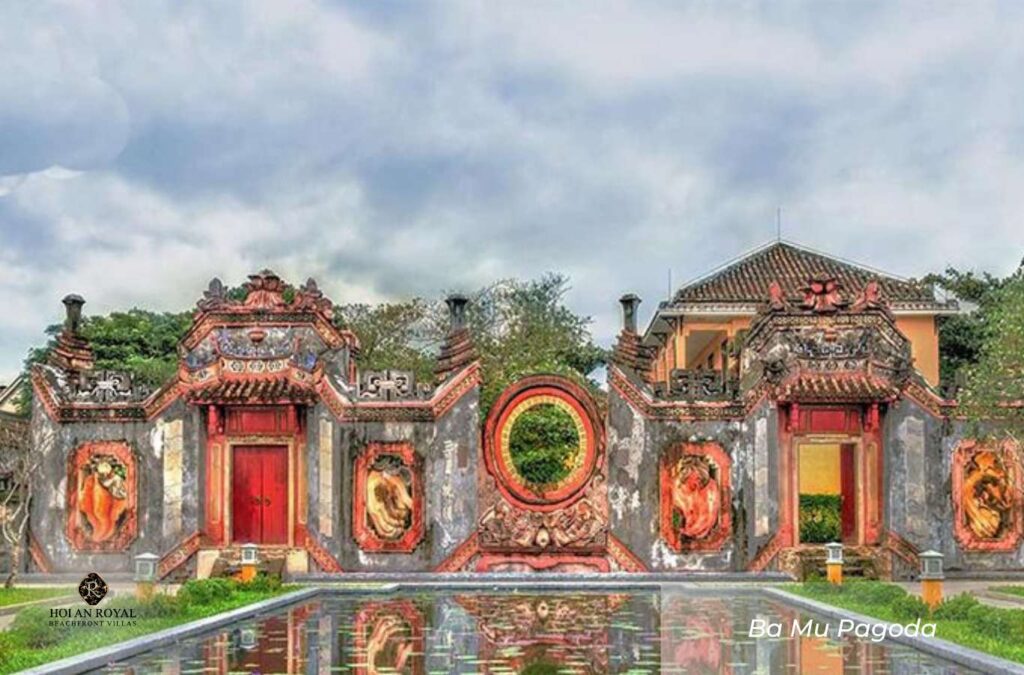
Phuoc Lam Temple
Phuoc Lam Temple is located in Thanh Ha commune, Hoi An, with a history of over 200 years. It is a representative temple featuring traditional East Asian architecture and serves as an important spiritual site. Founded by Zen master Thiet Dinh in the mid-18th century, the temple has undergone several renovations to preserve and expand its worship space.
Under the reign of King Duy Tan in 1910, the temple was granted the title “Bien vang sac tu” – an honor for solemn and meritorious temples.
The temple features the ‘Quoc’ character architectural layout, with a triple-gate entrance, a vast courtyard, and abundant greenery. The main hall has three compartments and two wings, a yin-yang tile roof shaped like a boat, and dragon decorations at the roof’s peak symbolizing power and reverence. On both sides are the bell tower, ancestral house, reception area, and kitchen.
The temple worships Buddha Shakyamuni and Bodhisattva Avalokiteshvara – deities revered in East Asian culture. Many ancient statues hundreds of years old, though weathered by time, still retain their solemn aura. The temple sits on elevated land, with a large pond in front and sand hills behind, creating a peaceful landscape ideal for practice and relaxation.

Chuc Thanh Temple (Khoai Temple)
Chuc Thanh Temple, also known as Khoai Temple, is one of the most sacred and ancient temples in Hoi An, with a history of over 300 years. Built in 1671 by Zen master Minh Hai from Quanzhou, China, the temple is the ancestral home of the Chuc Thanh Zen sect of the Linji school, attracting numerous Buddhists and visitors for pilgrimage.
The temple was constructed in the “Tam” character layout, heavily influenced by Chinese architecture mixed with Vietnamese culture and the distinctive traits of old Hoi An. The ancient triple-gate entrance features mossy tile roofs, carvings of symmetrical unicorns, and three lotus flowers symbolizing Buddhist teachings.
The main hall lies at the center of the premises, roofed with traditional yin-yang tiles, supported by strong wooden beams, and adorned with symmetrical dragon and phoenix carvings depicting the life of Buddha from birth to nirvana.
The rear sanctuary honors Pho Lien Hoa, Ksitigarbha, and Ai So Than, along with memorial altars and the monks’ quarters. The ancient tower complex contains 16 tombs, including the preserved body of Zen master Minh Hai and other monks, making it a sacred place for prayer.
Located in zone 7, Tan An ward, Hoi An City, about 2 km from the ancient town center, the temple is an important spiritual-cultural landmark marking the development of Linji Buddhism in Central Vietnam.
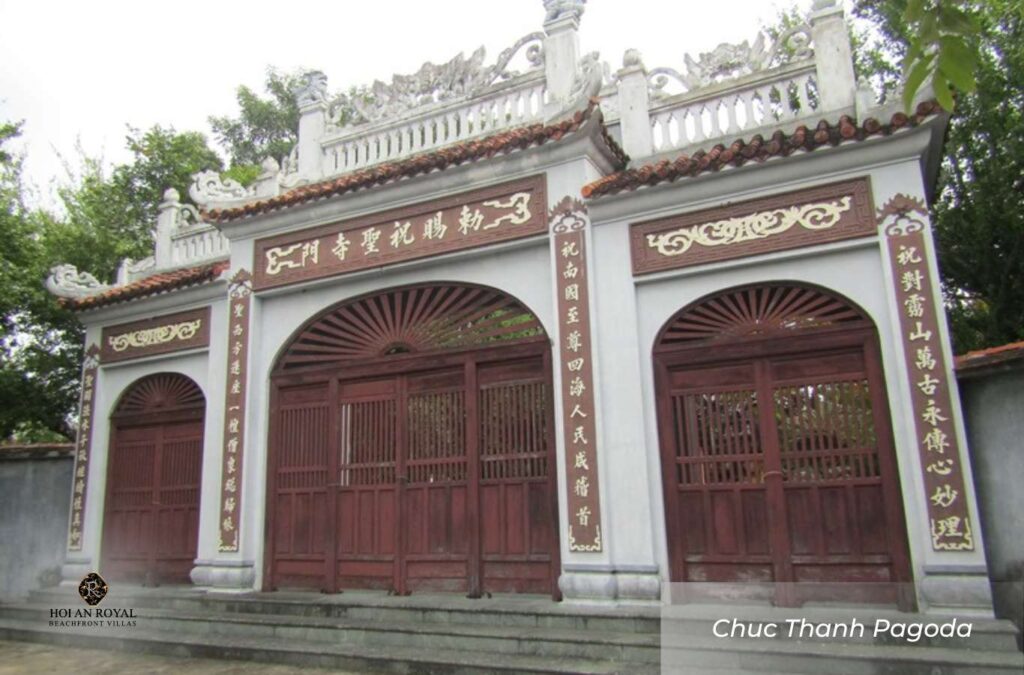
Phap Bao Temple
Phap Bao Temple is located at 07 Hai Ba Trung Street, and is one of the large and sacred temples in Hoi An ancient town.
Venerable Thich Bao Lac of the Linji Zen sect played a crucial role in establishing and developing the temple, especially after returning from Japan. In 2000, the temple was renovated and expanded, becoming both a spiritual center and a popular tourist site.
The temple’s architecture includes two floors, designed in the style of ancient Hoi An houses, exuding solemnity and tranquility. The main hall worships Buddha Shakyamuni, Maitreya Bodhisattva, Amitabha Buddha, and statues of Avalokiteshvara and Mahasthamaprapta Bodhisattvas, reflecting the diversity in Buddhist beliefs.
The temple frequently hosts major festivals, such as Vesak, drawing many Buddhists and visitors alike. It also offers retreats to help people find inner peace, especially during New Year and full moon days.
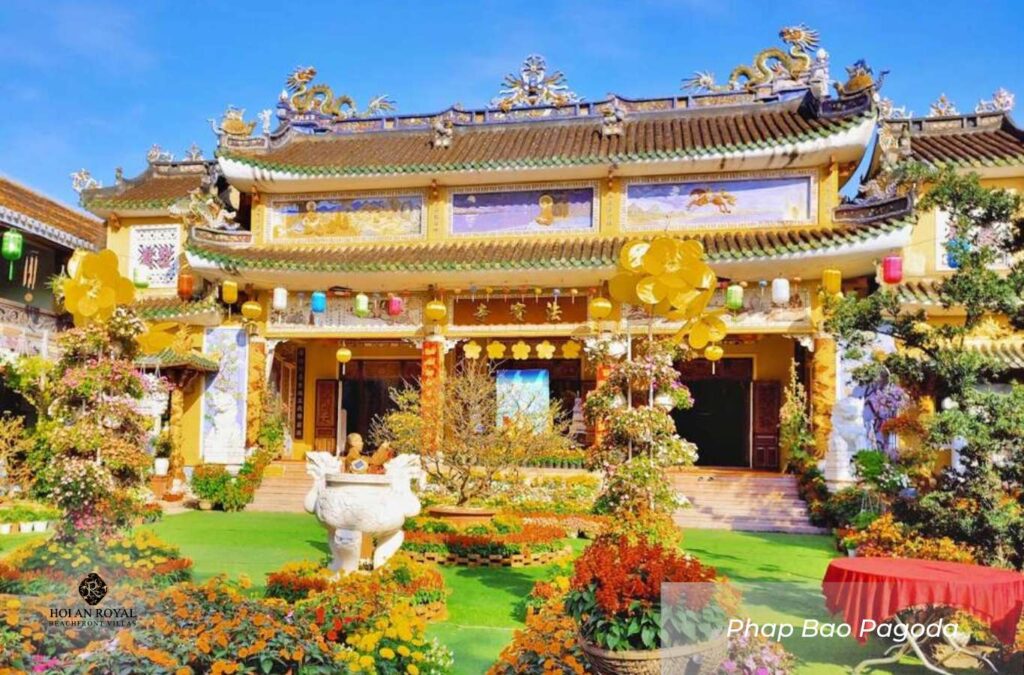
An Lac Temple
An Lac Temple has a history of nearly 60 years in Quang Nam, established in 1966 by Thich Hanh Son. Originally a small, modest hermitage, under the guidance of the late abbot, the temple gradually developed into a place for monastic training and spiritual guidance for Buddhists.
Its architecture stands out with a triple-gate entrance in distinct East Asian style, creating a serene atmosphere harmonized with the surrounding nature, ideal for worship and meditation.
Today, An Lac Temple is one of Hoi An’s important spiritual destinations, attracting many Buddhists and visitors who wish to explore local Buddhist culture.
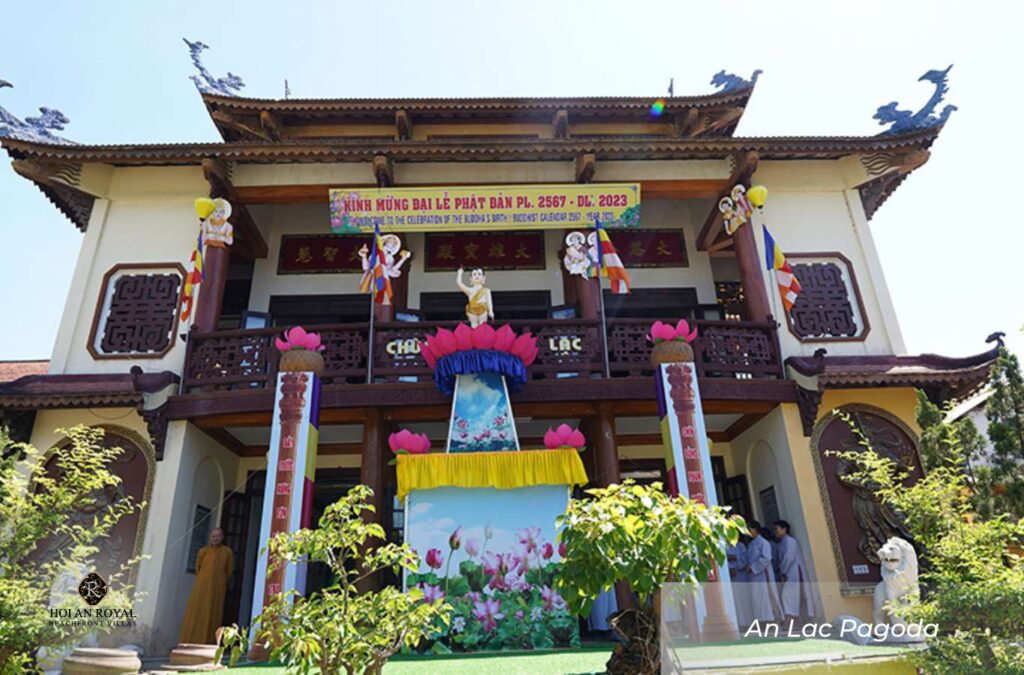
Vien Giac Temple
Vien Giac Temple is an ancient and sacred temple in Hoi An ancient town, seen as a spiritual and religious symbol for local people. Originally named Cam Ly, the temple was located in Xuyen Trung, but due to landslides in 1841, it was moved to 34 Hung Vuong Street, Cam Pho ward, Hoi An.
The temple was built in the traditional ancient architecture of Quang Nam and follows the Northern sect. In 1990, it underwent major restoration under the guidance of Venerable Thich Long Tri and was recognized as a national historical site in 1992.
The architecture features East Asian style, blending Vietnamese and Chinese elements in a simple yet solemn layout. The main hall houses a meditating statue of Buddha Shakyamuni on a lotus pedestal, flanked by statues of Avalokiteshvara and Ksitigarbha, with a statue of the infant Buddha in front.
The grounds also include a three-tiered Dang Quang ceramic tower with fish-turned-dragon-shaped roof tiles, housing Buddha relics and mementos from past abbots.
Vien Giac Temple is a key spiritual center, attracting many Buddhists and visitors, especially during major festivals like Vesak and Ullambana. The peaceful, green surroundings offer a tranquil and serene experience.
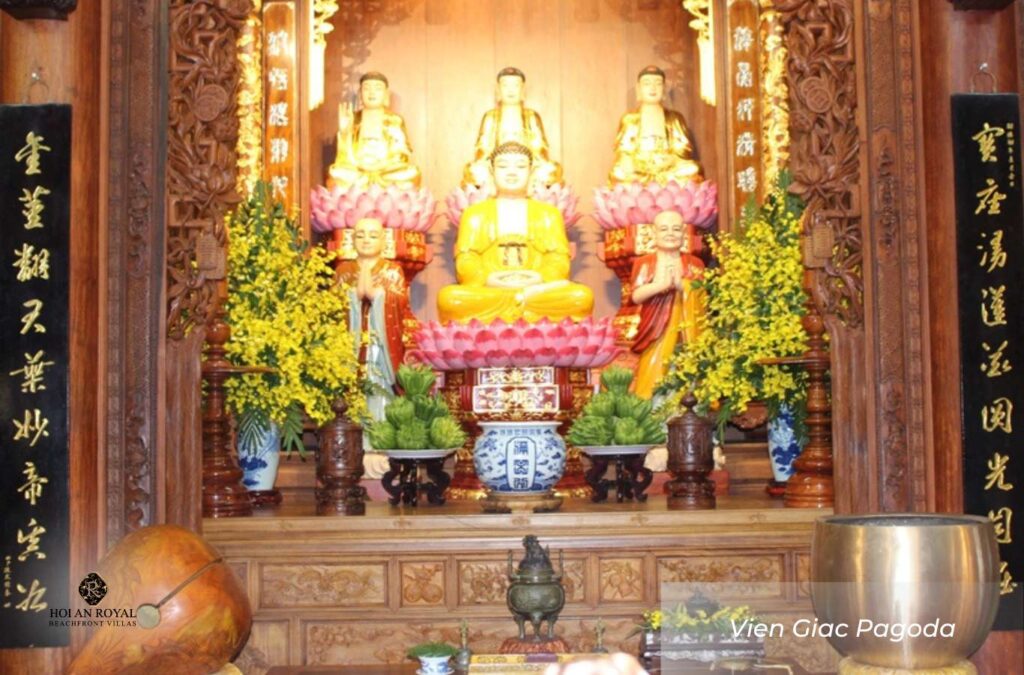
Van Duc Temple
Van Duc Temple is one of the important ancient temples in Hoi An, belonging to the Chuc Thanh lineage of the Linji Zen sect. It was established in the late 17th to early 18th century by Zen master Minh Luong from Chaozhou, China. Originally a small hermitage in Cam Ha commune, it was gradually expanded and renamed from Lang Tho Tu to Van Duc.
The temple underwent several restorations, the largest in the late 18th and early 20th centuries, rebuilt with lime and bricks, expanding the front hall, rear sanctuary, east-west wings, and adjusting its orientation for feng shui. It is currently overseen by Venerable Thich Dong Phuoc.
The architecture is grand and ancient, featuring large wooden pillars, yin-yang tiled roofs, and finely carved artworks. Its grounds are located on the right bank of the Co Co River, offering a peaceful space with harmoniously arranged functional areas.
The temple preserves many valuable artifacts such as engraved wooden panels, ancient statues, bronze bells, parallel sentences, and horizontal boards. Recognized as a National Historical and Cultural Site in 1991, it is a vital religious center that attracts Buddhists and tourists.

Hai Tang Temple (Cu Lao Cham)
Hai Tang Temple is located on Cham Island, Tan Hiep commune, Hoi An, Quang Nam. With nearly 300 years of history, it was built in 1758 during the reign of King Canh Hung. Originally a thatched hermitage founded by Zen master Huong Hai for spiritual practice, it was rebuilt by the fourth generation and named Hai Tang.
In 1848, after being damaged by a storm, the temple was relocated to Xom Cam, Bai Lang, and rebuilt sturdily with high stone walls to keep out snakes. Nestled at the foot of Hon Lao mountain, it faces the island’s only rice valley, offering ideal feng shui and a tranquil landscape.
The temple’s design combines worship of Buddha and local deities, serving the faith of fishermen and visiting merchant ships from Buddhist countries. It houses a large bronze bell from the early Le dynasty, intricately engraved with dragon motifs. The temple is open from 8:00 AM to 5:00 PM with free entry.
Hai Tang Temple is a sacred site and a famous cultural tourist destination on the island. Currently, it has no resident monks and is cared for by an elderly couple.
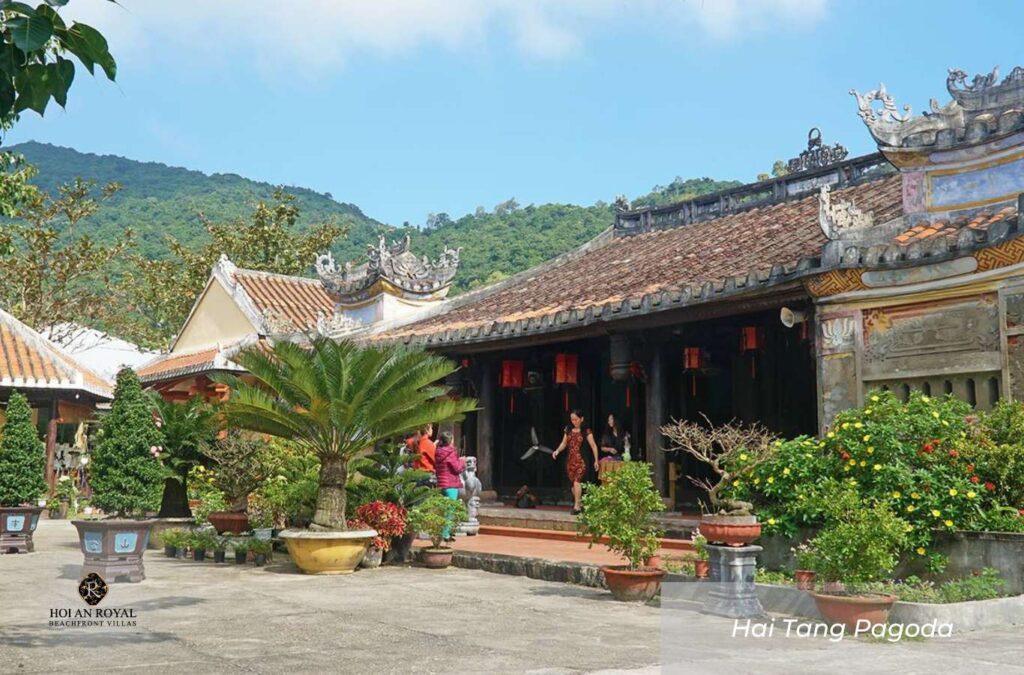
Tips for visiting Hoi An temples
These tips for visiting Hoi An pagoda will help you enjoy a meaningful trip while showing respect for these sacred places:
- Visit in the early morning (7:00 – 10:00) or late afternoon (15:00 – 17:00) to avoid the heat and enjoy the fresh, peaceful atmosphere.
- Dress modestly and respectfully, in accordance with local customs and the sacred nature of the space.
- Avoid wearing overly short, revealing, or transparent clothes to maintain the sanctity of the temple.
- Keep quiet, walk gently, avoid speaking loudly or joking, to preserve the temple’s tranquil space.
- Do not touch artifacts, Buddha statues, or worship items to prevent damage and show respect.
- When entering the main hall, bow to the Buddha, walk gently, and offer incense at the main altar and side altars.
- Avoid burning too much incense, especially in the main hall and surrounding shrines.
- Consider walking or renting a bicycle for your visit, as many temples are located close together in the ancient town, making it convenient to move around and soak in the historic atmosphere.
- Some temples like the Japanese Covered Bridge do not allow vehicle access, so park outside and walk in.
- Turn off your phone or switch to silent mode when inside temples to maintain the quiet environment.
- If you wish to film, take photos, or learn more about the temple’s history, ask for permission from the temple beforehand to avoid disturbing the monks or nuns.
- You may draw a fortune stick for blessings at some temples, but make sure to understand the correct procedure and interpretation.
Hoi An temples are essential stops on your journey to discover the cultural and spiritual depth of the ancient town. Each temple carries layers of Hoi An history, unique architecture, and a rare tranquility, contributing to the soul of Hoi An’s heritage.
To make your journey complete, consider staying at Hoi An Royal Beachfront Villas – a luxury resort just 10 minutes from the ancient town. With 497 sea-facing rooms and 69 private pool villas, this destination offers a luxurious yet nature-friendly retreat.









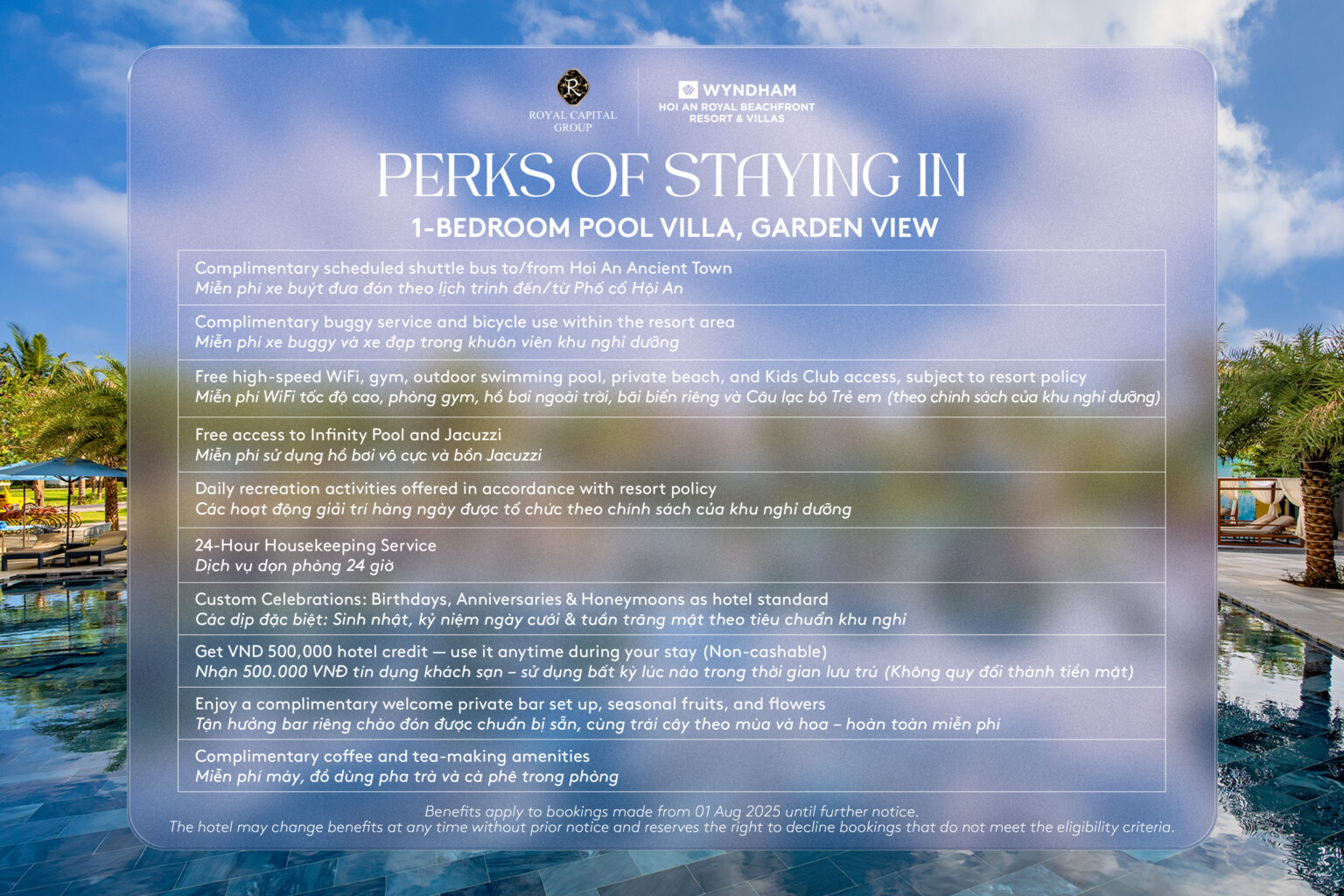
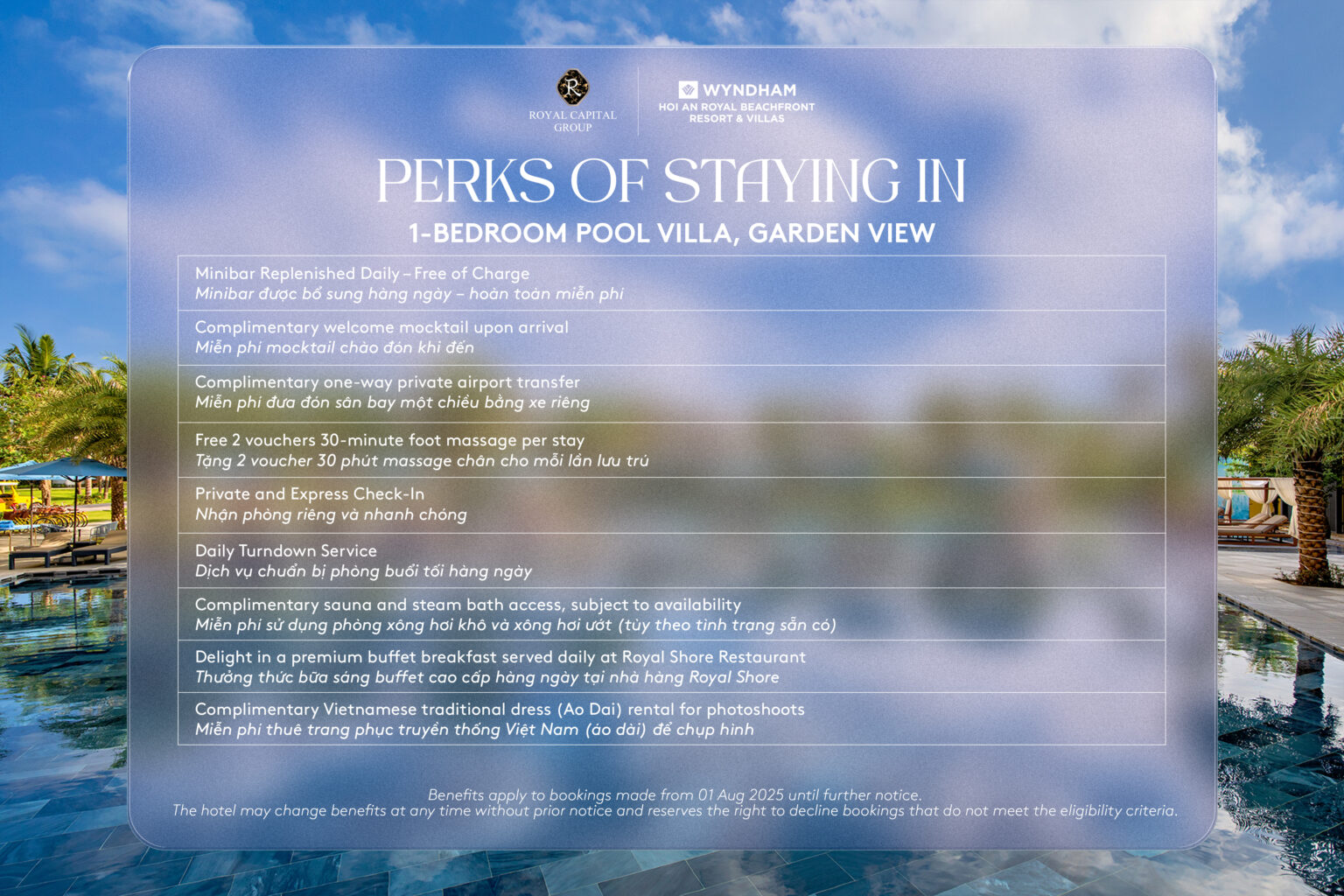
- Garden view
- 1 Twin Bedroom
- 50m2
Set amidst lush gardens with a private pool view, the One-Bedroom Garden View Villa is a spacious 55m² sanctuary designed for ultimate relaxation. Experience the charm of a villa VIP garden and pool Hoi An, where you can unwind in the elegant marble bathroom, complete with a deep soaking tub and refreshing rain shower. Plush twin beds invite restful slumber, while the tranquil setting sets the stage for a rejuvenating escape. Wake up refreshed, embrace the serenity, and make every moment of your stay truly unforgettable.
In addition, while staying here, you can relax at the infinity pool with a sea view, recharge with professional spa treatments, or enjoy refined cuisine at the two premium restaurants on the resort grounds.
Hoi An Royal Beachfront Villas also features an outdoor cinema, kids’ club, cooking classes, and a large-scale convention center – catering to every traveler’s needs. Visit the website of Hoi An Royal Beachfront Villas to book your stay today!
